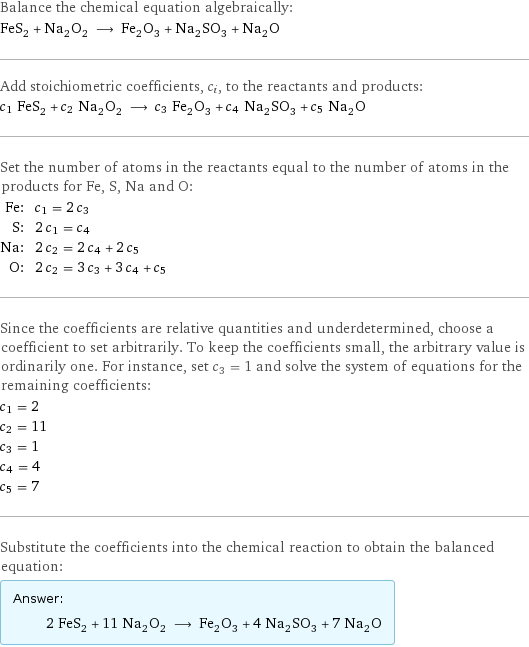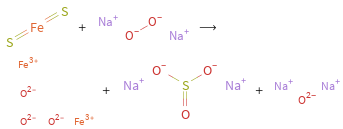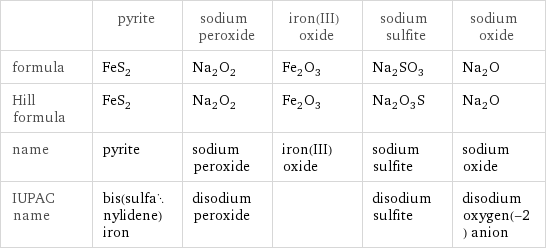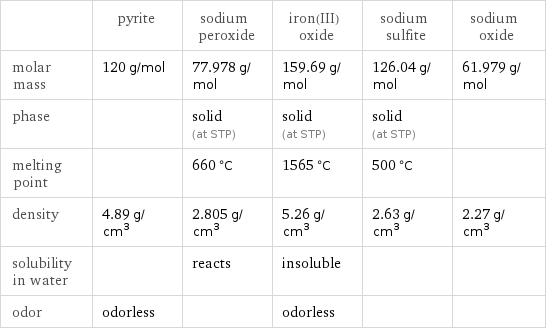Input interpretation

FeS_2 pyrite + Na_2O_2 sodium peroxide ⟶ Fe_2O_3 iron(III) oxide + Na_2SO_3 sodium sulfite + Na_2O sodium oxide
Balanced equation

Balance the chemical equation algebraically: FeS_2 + Na_2O_2 ⟶ Fe_2O_3 + Na_2SO_3 + Na_2O Add stoichiometric coefficients, c_i, to the reactants and products: c_1 FeS_2 + c_2 Na_2O_2 ⟶ c_3 Fe_2O_3 + c_4 Na_2SO_3 + c_5 Na_2O Set the number of atoms in the reactants equal to the number of atoms in the products for Fe, S, Na and O: Fe: | c_1 = 2 c_3 S: | 2 c_1 = c_4 Na: | 2 c_2 = 2 c_4 + 2 c_5 O: | 2 c_2 = 3 c_3 + 3 c_4 + c_5 Since the coefficients are relative quantities and underdetermined, choose a coefficient to set arbitrarily. To keep the coefficients small, the arbitrary value is ordinarily one. For instance, set c_3 = 1 and solve the system of equations for the remaining coefficients: c_1 = 2 c_2 = 11 c_3 = 1 c_4 = 4 c_5 = 7 Substitute the coefficients into the chemical reaction to obtain the balanced equation: Answer: | | 2 FeS_2 + 11 Na_2O_2 ⟶ Fe_2O_3 + 4 Na_2SO_3 + 7 Na_2O
Structures

+ ⟶ + +
Names

pyrite + sodium peroxide ⟶ iron(III) oxide + sodium sulfite + sodium oxide
Equilibrium constant
![Construct the equilibrium constant, K, expression for: FeS_2 + Na_2O_2 ⟶ Fe_2O_3 + Na_2SO_3 + Na_2O Plan: • Balance the chemical equation. • Determine the stoichiometric numbers. • Assemble the activity expression for each chemical species. • Use the activity expressions to build the equilibrium constant expression. Write the balanced chemical equation: 2 FeS_2 + 11 Na_2O_2 ⟶ Fe_2O_3 + 4 Na_2SO_3 + 7 Na_2O Assign stoichiometric numbers, ν_i, using the stoichiometric coefficients, c_i, from the balanced chemical equation in the following manner: ν_i = -c_i for reactants and ν_i = c_i for products: chemical species | c_i | ν_i FeS_2 | 2 | -2 Na_2O_2 | 11 | -11 Fe_2O_3 | 1 | 1 Na_2SO_3 | 4 | 4 Na_2O | 7 | 7 Assemble the activity expressions accounting for the state of matter and ν_i: chemical species | c_i | ν_i | activity expression FeS_2 | 2 | -2 | ([FeS2])^(-2) Na_2O_2 | 11 | -11 | ([Na2O2])^(-11) Fe_2O_3 | 1 | 1 | [Fe2O3] Na_2SO_3 | 4 | 4 | ([Na2SO3])^4 Na_2O | 7 | 7 | ([Na2O])^7 The equilibrium constant symbol in the concentration basis is: K_c Mulitply the activity expressions to arrive at the K_c expression: Answer: | | K_c = ([FeS2])^(-2) ([Na2O2])^(-11) [Fe2O3] ([Na2SO3])^4 ([Na2O])^7 = ([Fe2O3] ([Na2SO3])^4 ([Na2O])^7)/(([FeS2])^2 ([Na2O2])^11)](../image_source/eed79498927c5f31ef0599d16438f40b.png)
Construct the equilibrium constant, K, expression for: FeS_2 + Na_2O_2 ⟶ Fe_2O_3 + Na_2SO_3 + Na_2O Plan: • Balance the chemical equation. • Determine the stoichiometric numbers. • Assemble the activity expression for each chemical species. • Use the activity expressions to build the equilibrium constant expression. Write the balanced chemical equation: 2 FeS_2 + 11 Na_2O_2 ⟶ Fe_2O_3 + 4 Na_2SO_3 + 7 Na_2O Assign stoichiometric numbers, ν_i, using the stoichiometric coefficients, c_i, from the balanced chemical equation in the following manner: ν_i = -c_i for reactants and ν_i = c_i for products: chemical species | c_i | ν_i FeS_2 | 2 | -2 Na_2O_2 | 11 | -11 Fe_2O_3 | 1 | 1 Na_2SO_3 | 4 | 4 Na_2O | 7 | 7 Assemble the activity expressions accounting for the state of matter and ν_i: chemical species | c_i | ν_i | activity expression FeS_2 | 2 | -2 | ([FeS2])^(-2) Na_2O_2 | 11 | -11 | ([Na2O2])^(-11) Fe_2O_3 | 1 | 1 | [Fe2O3] Na_2SO_3 | 4 | 4 | ([Na2SO3])^4 Na_2O | 7 | 7 | ([Na2O])^7 The equilibrium constant symbol in the concentration basis is: K_c Mulitply the activity expressions to arrive at the K_c expression: Answer: | | K_c = ([FeS2])^(-2) ([Na2O2])^(-11) [Fe2O3] ([Na2SO3])^4 ([Na2O])^7 = ([Fe2O3] ([Na2SO3])^4 ([Na2O])^7)/(([FeS2])^2 ([Na2O2])^11)
Rate of reaction
![Construct the rate of reaction expression for: FeS_2 + Na_2O_2 ⟶ Fe_2O_3 + Na_2SO_3 + Na_2O Plan: • Balance the chemical equation. • Determine the stoichiometric numbers. • Assemble the rate term for each chemical species. • Write the rate of reaction expression. Write the balanced chemical equation: 2 FeS_2 + 11 Na_2O_2 ⟶ Fe_2O_3 + 4 Na_2SO_3 + 7 Na_2O Assign stoichiometric numbers, ν_i, using the stoichiometric coefficients, c_i, from the balanced chemical equation in the following manner: ν_i = -c_i for reactants and ν_i = c_i for products: chemical species | c_i | ν_i FeS_2 | 2 | -2 Na_2O_2 | 11 | -11 Fe_2O_3 | 1 | 1 Na_2SO_3 | 4 | 4 Na_2O | 7 | 7 The rate term for each chemical species, B_i, is 1/ν_i(Δ[B_i])/(Δt) where [B_i] is the amount concentration and t is time: chemical species | c_i | ν_i | rate term FeS_2 | 2 | -2 | -1/2 (Δ[FeS2])/(Δt) Na_2O_2 | 11 | -11 | -1/11 (Δ[Na2O2])/(Δt) Fe_2O_3 | 1 | 1 | (Δ[Fe2O3])/(Δt) Na_2SO_3 | 4 | 4 | 1/4 (Δ[Na2SO3])/(Δt) Na_2O | 7 | 7 | 1/7 (Δ[Na2O])/(Δt) (for infinitesimal rate of change, replace Δ with d) Set the rate terms equal to each other to arrive at the rate expression: Answer: | | rate = -1/2 (Δ[FeS2])/(Δt) = -1/11 (Δ[Na2O2])/(Δt) = (Δ[Fe2O3])/(Δt) = 1/4 (Δ[Na2SO3])/(Δt) = 1/7 (Δ[Na2O])/(Δt) (assuming constant volume and no accumulation of intermediates or side products)](../image_source/696802eb4edcf9f22cb796a5f7e6c497.png)
Construct the rate of reaction expression for: FeS_2 + Na_2O_2 ⟶ Fe_2O_3 + Na_2SO_3 + Na_2O Plan: • Balance the chemical equation. • Determine the stoichiometric numbers. • Assemble the rate term for each chemical species. • Write the rate of reaction expression. Write the balanced chemical equation: 2 FeS_2 + 11 Na_2O_2 ⟶ Fe_2O_3 + 4 Na_2SO_3 + 7 Na_2O Assign stoichiometric numbers, ν_i, using the stoichiometric coefficients, c_i, from the balanced chemical equation in the following manner: ν_i = -c_i for reactants and ν_i = c_i for products: chemical species | c_i | ν_i FeS_2 | 2 | -2 Na_2O_2 | 11 | -11 Fe_2O_3 | 1 | 1 Na_2SO_3 | 4 | 4 Na_2O | 7 | 7 The rate term for each chemical species, B_i, is 1/ν_i(Δ[B_i])/(Δt) where [B_i] is the amount concentration and t is time: chemical species | c_i | ν_i | rate term FeS_2 | 2 | -2 | -1/2 (Δ[FeS2])/(Δt) Na_2O_2 | 11 | -11 | -1/11 (Δ[Na2O2])/(Δt) Fe_2O_3 | 1 | 1 | (Δ[Fe2O3])/(Δt) Na_2SO_3 | 4 | 4 | 1/4 (Δ[Na2SO3])/(Δt) Na_2O | 7 | 7 | 1/7 (Δ[Na2O])/(Δt) (for infinitesimal rate of change, replace Δ with d) Set the rate terms equal to each other to arrive at the rate expression: Answer: | | rate = -1/2 (Δ[FeS2])/(Δt) = -1/11 (Δ[Na2O2])/(Δt) = (Δ[Fe2O3])/(Δt) = 1/4 (Δ[Na2SO3])/(Δt) = 1/7 (Δ[Na2O])/(Δt) (assuming constant volume and no accumulation of intermediates or side products)
Chemical names and formulas

| pyrite | sodium peroxide | iron(III) oxide | sodium sulfite | sodium oxide formula | FeS_2 | Na_2O_2 | Fe_2O_3 | Na_2SO_3 | Na_2O Hill formula | FeS_2 | Na_2O_2 | Fe_2O_3 | Na_2O_3S | Na_2O name | pyrite | sodium peroxide | iron(III) oxide | sodium sulfite | sodium oxide IUPAC name | bis(sulfanylidene)iron | disodium peroxide | | disodium sulfite | disodium oxygen(-2) anion
Substance properties

| pyrite | sodium peroxide | iron(III) oxide | sodium sulfite | sodium oxide molar mass | 120 g/mol | 77.978 g/mol | 159.69 g/mol | 126.04 g/mol | 61.979 g/mol phase | | solid (at STP) | solid (at STP) | solid (at STP) | melting point | | 660 °C | 1565 °C | 500 °C | density | 4.89 g/cm^3 | 2.805 g/cm^3 | 5.26 g/cm^3 | 2.63 g/cm^3 | 2.27 g/cm^3 solubility in water | | reacts | insoluble | | odor | odorless | | odorless | |
Units
